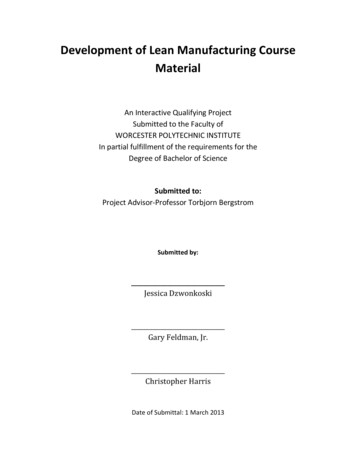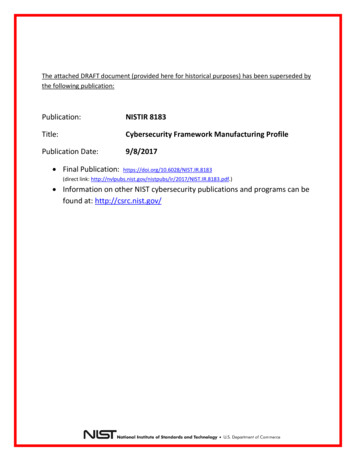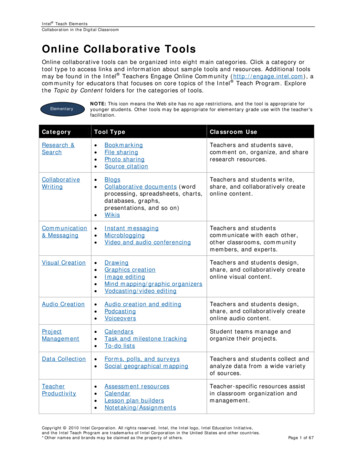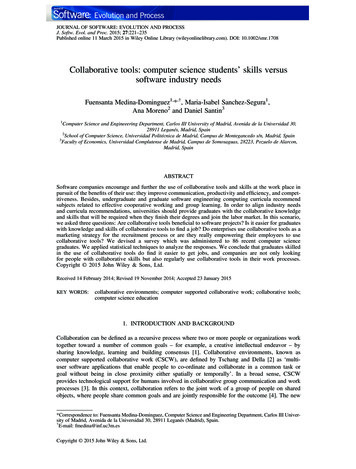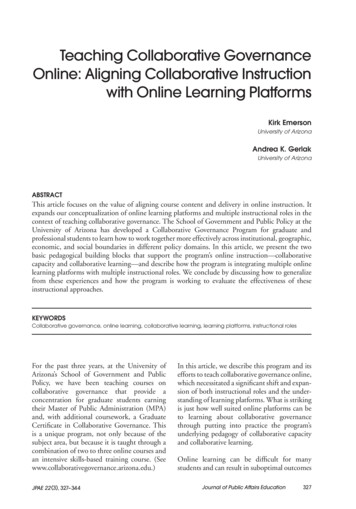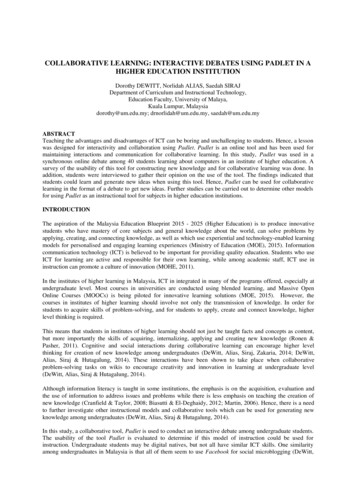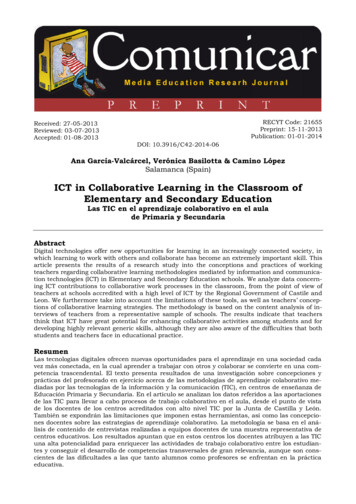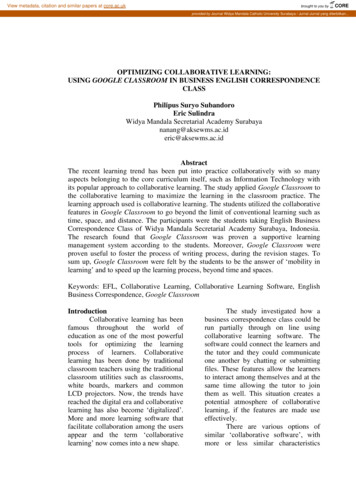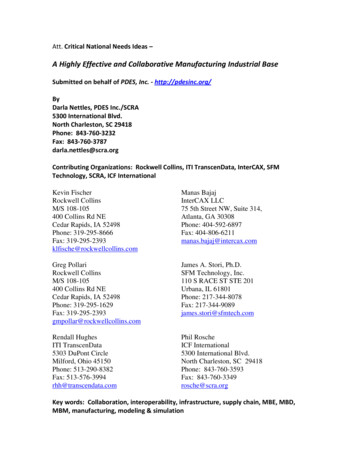
Transcription
Att. Critical National Needs Ideas –A Highly Effective and Collaborative Manufacturing Industrial BaseSubmitted on behalf of PDES, Inc. ‐ http://pdesinc.org/ByDarla Nettles, PDES Inc./SCRA5300 International Blvd.North Charleston, SC 29418Phone: 843‐760‐3232Fax: 843‐760‐3787darla.nettles@scra.orgContributing Organizations: Rockwell Collins, ITI TranscenData, InterCAX, SFMTechnology, SCRA, ICF InternationalKevin FischerRockwell CollinsM/S 108-105400 Collins Rd NECedar Rapids, IA 52498Phone: 319-295-8666Fax: 319-295-2393klfische@rockwellcollins.comManas BajajInterCAX LLC75 5th Street NW, Suite 314,Atlanta, GA 30308Phone: 404-592-6897Fax: 404-806-6211manas.bajaj@intercax.comGreg PollariRockwell CollinsM/S 108-105400 Collins Rd NECedar Rapids, IA 52498Phone: 319-295-1629Fax: 319-295-2393gmpollar@rockwellcollins.comJames A. Stori, Ph.D.SFM Technology, Inc.110 S RACE ST STE 201Urbana, IL 61801Phone: 217-344-8078Fax: 217-344-9089james.stori@sfmtech.comRendall HughesITI TranscenData5303 DuPont CircleMilford, Ohio 45150Phone: 513-290-8382Fax: 513-576-3994rhh@transcendata.comPhil RoscheICF International5300 International Blvd.North Charleston, SC 29418Phone: 843-760-3593Fax: 843-760-3349rosche@scra.orgKey words: Collaboration, interoperability, infrastructure, supply chain, MBE, MBD,MBM, manufacturing, modeling & simulation
AN AREA OF CRITICAL NATIONAL NEEDThe area selected as Critical National Need is “A Highly Effective and CollaborativeManufacturing Industrial Base.” This critical national need was selected with the largerview that a viable manufacturing base is absolutely essential to stimulate and sustainthe U.S. economy, maintain our national security, and ensure our preeminent leadershipin technology and innovation. Inputs regarding potential areas of this critical nationalneed were obtained from government agencies and advisory bodies, industryorganizations, leading researchers and academic institutions, and others.The current administration has described two primary objectives for manufacturing inthe next four years. First, invest in our Next Generation Innovators and Job Creators toidentify the most compelling advanced manufacturing strategies. And Double Fundingfor the Manufacturing Extension Partnership: The Manufacturing Extension Partnership(MEP) works with manufacturers across the country to improve efficiency, implementnew technology and strengthen company growth. The goal of providing “A HighlyEffective and Collaborative Manufacturing Industrial Base” requires innovation andtechnology to achieve higher levels of efficiency that ultimately drives industry growth.The manufacturing sector continues to decline in terms of jobs for American workers.The primary driving factor is cost. The only way to drive cost down and turn around thedecline is to make U.S. based manufacturing enterprises the most efficient in the world.These efficiencies are within the enterprise and across the extended enterprise. Thereare many elements necessary to achieve this including creating the ability for companiesto interact with each other seamlessly and instantaneously. This capability requires theuse, application, integration and synthesis of multiple standards and technologies withinand between manufacturing enterprises.The desired output of work funded through this competition is an implementableModel‐Based Interoperability Infrastructure. Much as we depend on maintaining ourCivil Infrastructure to quickly and reliably transport the physical goods and supplies usedacross our manufacturing industrial base, we need a strong viable Model‐BasedInteroperability Infrastructure to quickly and reliably transport our digital informationused throughout the product lifecycle. This seamless modeling framework should bebased upon the interoperability of open data standards as well as the plug‐n‐playcharacteristics of system oriented architecture; allowing digital models to smoothly“travel” over a well‐defined ubiquitous and available infrastructure. Maximum value ofthe model‐based industrial enterprise can only be realized if the models are highlyinteroperable across the product lifecycle applications and if there is a viable long‐termperspective for the transport and archival of the model data.Manufacturing is vital to the nation for both economic and security purposes. It isessential that the U.S. maintain and enhance its global manufacturing competitivenessthrough innovation and technology development. The need is critical becauseglobalization and other external drivers increasingly shape our industrial base and themanufacturing enterprise. 21st century manufacturing requires not only innovative1
fabrication and process technologies, but also effective design disciplines, globallycollaborative networks and a highly capable workforce. This point has beenunderscored by industry in studies from associations such as the National Council ForAdvanced Manufacturing, Aerospace Industries Association, National Defense IndustrialAssociation, and others. A recent NDIA white paper sent a strong message when itstated, “if we lose our preeminence in manufacturing technology, then we lose ournational security.”MAGNITUDE OF THE PROBLEMModel Based Interoperability Infrastructure – the seamless framework for Model BasedEnterprise and Network Centric data systems – consists of open data standards andsystem oriented architecture. As the global competitiveness of manufacturing grows,we become more dependent upon our innovation and speed to market. A network‐focused approach, organized around achieving a “single digital thread” helps fullyleverage innovation from all tiers in the supply chain and across the total life cycle ofproducts.From the U.S. Department of Defense (DoD) perspective, the DoD ManTech Programdraft Strategic Plan describes relevant critical needs through two of its Strategic Thrusts:Active Support for a Highly Connected and Collaborative Defense ManufacturingEnterprise and Active Support for a Strong Institutional Focus on Manufacturability andManufacturing Process Maturity. One key enabling goal to accomplish the first StrategicThrust encompasses the research, development and implementation of capabilities suchas Model Based Enterprise, Network Centric Manufacturing, collaborative modeling andsimulation, and best commercial practices. This goal supports developing industrialcapabilities that allow a rapid response to dynamically changing defense needs.Another goal supporting the second Strategic Thrust describes the need for fullintegration of Design for Manufacturability.Even though the ManTech Strategic Plan specifically addresses DoD needs, these issuesare broadly applicable to the US manufacturing industry as a whole, includingautomotive, aerospace or consumer electronics.The trend in manufacturing is toward a hypercompetitive global marketplace, driven bya growing number of nations striving to develop strong manufacturing economies. U.S. manufacturing faces stiff and ousting competition from low costmanufacturing in developing countries; 16% manufacturing jobs lost from 2000‐2003 and 4% from 2003‐2008 [EPI Paper] – approximately 3 million jobs lost inlast decade, massive trade deficit in terms of goods ( 677 billion at the end of2008). It is caught between developed countries leading on product and processinnovation and developing countries competing on price and availability of largeworkforce. U.S. manufacturing must compete on innovative products, quality, productivity,environmental impact, skilled workforce, and other socio‐economic factors.2
U.S. manufacturing must compete on design and operation of agile, lean, green,and sustainable manufacturing systems. Beyond the product, manufacturingsystems must incorporate environment, infrastructure, government policies,business environment, and rapidly changing product/process technologylandscape to be sustainable and viable in the long‐term.SOCIETAL CHALLENGESSocietal challenges are defined as problems or issues confronted by society that whennot addressed could negatively affect the overall function and quality of life of thenation, and as such justify government attention. In order to address the CriticalNational Need for a Model Based Interoperability Infrastructure, there are severalsocietal challenges that must be overcome. The following societal challenges havemaximum adverse impact on the resurgence of US manufacturing.The cost savings, due to lower labor cost, of offshore manufacturing are partially offsetwith the cost associated with managing the offshore resources, dealing with languageissues, lower quality, as well as distance and the time differences between countries. Byapplying innovative advanced manufacturing technologies in conjunction with othergovernmental policies regarding trade and taxes, we will be able to ensure significantamounts of manufacturing work in the U.S. However, without these advances, thepractice of manufacturing offshore can only continue to accelerate.Core to these societal challenges is the ability of U.S. manufacturing enterprises todevelop and adopt innovative product, process, and systems technology. Costs andschedules for manufacturing are driven primarily by activities “above the shop floor”,that is, in enterprise level processes, business practices, and interactions across thesupply chain. 21st century manufacturing will rely on a networked, collaborative andincreasingly global supply base. To enable a highly connected manufacturing enterprise,it is critical to research, develop, and implement capabilities that allow for a highlycollaborative Interoperability Infrastructure. Specific initiatives include Model BasedEnterprise (including Model Based Manufacturing), Network Centric data environments,Integrated design and operation of manufacturing systems, and Collaborative Modeling& Simulation capabilities.Recent industry studies on Network Centric Manufacturing and Model Based Enterpriseconcepts suggest that these initiatives hold promise. The objectives of MBE include ahighly integrated design for manufacturability capability, increased fidelity in costmodeling, pre‐production test and validation, and first article quality. Major elementsrequired for implementation include 3‐D modeling, manufacturing simulation, verifiedsystem, component, and process models, as well as visualization of end‐to‐endproduction and test processes. The promise is the ability to cycle through multipledesign, model, and test cycles before producing the final system with confidence. All ofwhich depends upon infrastructure to seamlessly transport and use data across theproduct lifecycle.3
But challenges exist that prevent the U.S. from achieving highly effective andcollaborative manufacturing enterprises crosses all enterprises, their software andhardware environments, the national information networks (internet andtelecommunications) and information technology and integration service providers.Historically these challenges have been met with “point‐to‐point” solutions andstandards. Most of these point‐to‐point standards exist today but industry has notsuccessfully deployed interoperability capabilities that require the use of multiplestandards and technologies. Furthermore, small manufacturing enterprises are not ableto participate in the integration process due to cost, time and expertise barriers.Research is needed to understand how industry can begin to achieve higher levels ofefficiency across technologies and standards. The impact of a tightly coupled, seamlessmanufacturing industrial base will be significant cost reductions such that the cost ofkeeping work onshore is equal to or less than the total cost of off shoring work, thushelping to reduce the number or manufacturing jobs going offshore and helping toincrease the number or manufacturing jobs onshore.Another societal challenge to consider is the competitive nature of business as it drivescompanies to protect their intellectual property. This appears to be in conflict with theneed to seamlessly collaborate and share knowledge and information. The complexitiesof the 21st century business landscape create situations where the same companies cansimultaneously be in a supplier‐customer relationship, a competitive relationship and acollaborative relationship. The resulting uncertainty can create an unwillingness tocollaborate, which in turn can make it difficult to compete globally. This yieldsinefficiencies that increase societal costs as seen in wasted time, missed opportunitiesand inefficient use of resources.EVIDENCE OF COMMITMENTTechnological innovation creates new products, opens new markets and creates newways of making products we depend upon. Some economists estimate that about halfof the U.S. economic growth since World War II has been the result of technologicalinnovation. The U.S. not only boasts the highest‐skilled workers in the world, but alsothe most innovative scientists, businesses and entrepreneurs who develop newproducts and innovations. However, America is in danger of losing its technologicaledge. The U.S. is today a net importer of high‐technology products. The U.S. mustinvest in the most compelling advanced manufacturing strategies. The U.S. must retainits competitive advantage in industries of national importance. Ensuring thecompetitiveness of U.S. technology‐based business ensures that 21st century jobs canand will grow in America. It is often federally‐supported basic research that hasgenerated the innovations to create markets and drive economic growth. America’slong‐term competitiveness depends on the speed and flexibility of a highly collaborativemanufacturing industrial base. This can only be achieved with a ubiquitous Model‐Based Interoperability Infrastructure.4
Evidence of commitment has been shown in the U.S. for the past three decades. NISThas helped sponsor and support the standards for product data exchange, networkingstandards, file format standards, etc. Industry associations such as AIA haveinteroperability initiatives working to address part of the problem. The DoD ManTechprogram supports numerous initiatives in the areas of Model Base Enterprise andNetwork Centric Manufacturing. Industry participates in numerous organizations thatsupport interoperability and standards development. Examples include PDES, Inc., OpenApplications Group (OAG), NACFAM, INCOSE, OMG, OASIS, CAM‐I, NDIA, etc. Many ofthese standards organizations are working more effectively together to harmonize thevarious standards and ensure they interoperate. Some companies are able to achievesuccess in a few areas by themselves but the key is to have a significant percentage ofcompanies achieve success for a significant percentage of the problem areas. A notionalinteroperability infrastructure is essential to the viability of U.S. manufacturing.STIMULATING THE NATION’S SCIENTIFIC FRONTIERSA robust and reliable Model Based Interoperability Infrastructure is a critical national(even global) need that must be addressed in order to ensure U.S. leadership. TheNational Research Council identified key technologies for the future of manufacturingthat include interoperability and interoperability standards; pervasive and adaptiveprocess control; advanced learning technology; global collaborative capabilities;enterprise‐wide supply network management; knowledge management and navigationtools; security and other protection systems; modeling and simulation technology;wireless and remote communication; software to enhance moving from ideas toproducts; and the incorporation of intelligence into processes and products.Research to be DevelopedAdvances in commercial manufacturing that have the greatest potential impact include:industry collaboration, adaptive enterprises, high‐performance organizations, life‐cycleperspectives, advanced manufacturing processing technology, environmentallycompatible manufacturing, and shared information environments. These advancesinteract with each other and are composed of the following elements: Advanced approaches to product design, including life‐cycle design, integratedproduct and process development, three‐dimensional digital product models,simulation and modeling, and rapid prototyping. Advanced approaches to manufacturing processes, including generativenumerical control, adaptive machine control, predictive process control, high‐speed machining, flexible tooling, soft tooling, tool‐less assembly, embeddedsensors, flip chips, nanotechnology, and biotechnology. Information and communications technologies, including electronic commerce,virtual co‐location of people, data interchange standards, Internet technologies,intranet technologies, browser technologies, intelligent agents, seamless dataenvironments, telecommunications, and distance learning. This will enable thecreation of a ubiquitous model based interoperability infrastructure to quickly5
and cost effectively transport digital information across the manufacturingindustrial base.MEETING TIMELY NEEDS NOT MET BY OTHERSComplexityToday, manufacturing systems are large scale complex systems. Design, development,operation, and maintenance of such systems require the use of a systems approach andsystems engineering toward manufacturing entities. The manufacturing system is aproduct itself – with its own lifecycle. Manufacturing systems must fulfill roles beyondjust manufacturing products. These systems must: Quickly adapt to fast changing business landscapes and custom requirements forbetter, faster, and cheaper products Efficiently and productively reduce costs and afford business to be economicallysustainable Efficiently use energy and enable reduction of fossil fuel dependency Respond to the environment – emissions of greenhouse gases, use and disposalof toxic and hazardous materials, recycle waste and energy Account for socio‐economics issues – support the livelihood of thousands offamilies, account for the education of future generations, help build a long‐termcareer stability Account for government regulations and policiesInteroperabilityManufacturing enterprises are no longer self‐contained organizations; they are part of aglobalized supply chain. The different computer systems used by each member of asupply chain are not able to seamlessly interoperate with the others. This implies thatinformation created in one type of software at one organization cannot be read orshared with other similar types of software applications in the same or otherorganizations. Examples of lack of interoperability of CAD, CAE, CAM tools even afterdecades of application and standards development include: Interoperability issues with sharing information between partners in the supplychain; typically the leading organization forces its supplier base to use the samecomputer software systems – leading to large scale overhaul, training, andcompetency issues with the supplier organizations. And when a supplier servesmultiple customers, each demanding alignment, there is significant overhead,cost and waste that cannot be absorbed in competitive manufacturing. Lack of interoperability impedes the access and integration of informationanywhere, anytime; thereby creating problems in analyzing product designs,measuring quality, and verifying requirements. Quality control which ought to bea continuous process through the product development cycle cannot beaccomplished until later in the design and manufacturing stages. Lack of interoperability forces manual and semi‐automated methods of qualitycontrol; automated verification of product designs still subject to specific6
modules provided by COTS computer systems. If an enterprise wants to setupnew techniques for evaluating manufacturability of products or measure quality,it must endure long‐term, costly software development, integration, andqualification processes.Information must be managed at a much more granular level to be able toaddress IP issues as well as support analyses to verify product performance andquality. More often than not, analysis of products requires product informationthat is historically hidden and not shared by members of the manufacturingsupply chain. For example, design of high‐performance, better quality electronicsystems necessitates system‐level analyses that require detailed computermodels of the components (PCB, chip packages, cables, etc.) that are controlledand not shared by the OEM.StandardsLack of interoperability between business systems creates inefficiencies. WhenInformation Technology (IT) systems cannot communicate and exchange data andinformation, manual processes must be employed. This can, in turn, be a source oferrors and wasted time. While uncertainty and lack of interoperability createsconfusion and waste, certainty and interoperability promote efficiency and productivity.One example of how the government can create certainty is through standardsdevelopment. In this case, standards for data exchange and communication at thebusiness and technical level would allow companies to collaborate while still protectingintellectual property. Competitiveness is also enhanced when recognized governmentand international standards support interoperability between IT solutions from differenttool providers.With the recent developments in the areas web services communication andinformation modeling standards technology, the necessary capability to address theinteroperability issues exists and is ready for further extension and implementation.However, tool developers and software providers are reluctant to invest in thedevelopment of open standards on their own. Small companies cannot afford to do thisalone (and likely do not have enough industry market share or clout) and largecompanies want to dominate the market by creating and pushing their own proprietarystandards. What remains are industry collaborations or consortia who often rely on the“goodwill” of member companies to contribute effort and funds.A TRANSFORMATIONAL RESULTDeveloping and implementing a national Model Based Interoperability Infrastructurewould provide a truly transformational result that would enable disruptive changes overand above current methods and strategies. It would radically improve ourunderstanding of systems and technologies, challenging the status quo of researchapproaches and applications.7
The United States industrial base relies more and more on knowledge. Knowledge (inthe form of innovation, intellectual property, and data exchange throughout themanufacturing supply chain) is the basis for significant value in industry. Inefficiencies inknowledge and data exchange, transfer, reuse, and visibility can be a severe drag onproductivity – real and potential. Standards can streamline knowledge and informationexchange both within a company and between companies, customers and suppliers.Eliminating these inefficiencies reduces waste and improves national productivity whichin turn makes U.S. manufacturers more competitive globally while also leveraging globalopportunities. Just as the digital revolution in computers has enhanced nationalproductivity over the last two decades, so can a standards‐based framework,architecture and modeling languages accelerate the digital data revolution through theelimination of errors and waste, faster development cycle time and leveraged reuse ofintellectual property.Imagine the competitive manufacturing position for U.S. workers if a ubiquitousinteroperability infrastructure existed. The speed and flexibility to create highlyinnovative technologically advanced products would be phenomenal. The costeffectiveness from virtual models and analyzing new technology using virtualaugmented reality, all through a common interoperability infrastructure, would betremendous. Manufacturing processes could be optimized for maximum sustainabilitybefore any investment in facilities occurs. The most productive and innovative workersin the world would be provisioned with an interoperability infrastructure that ispervasive across the supply chain, unleashing tremendous collaborative capability.The impact to the nation when a solution is discovered and pervasively deployedthroughout the U.S. manufacturing industrial base will be dramatic cost savings inmanufacturing that provides industry the opportunity to re‐consider the cost‐benefit ofoffshore manufacturing. This change could be the catalyst for re‐invigorating U.S.manufacturing and creating a significant number of skilled job opportunities in the U.S.industrial base.WHY TIP?The Technology Innovation Program is in a unique position to provide the impetus tocreate a common U.S.‐wide Model Based Interoperability Infrastructure. We have seenrepeatedly in the course of history that large‐scale infrastructure changes must bedriven from the top down. One of the chief motivators for developing an interstatehighway system was to end the economic stress of the country and create jobs – notjust for the physical laborer, but for the designers, planners, and support systems thatwent with those highways. At the beginning of the 20th century, federal funding wasgiven to the states, which in turn, developed their own systems of roads and even trafficlaws. It was not until the 1950’s that federal government provided the impetus, both infunding and direction, enabling nation‐wide interstate commerce. A uniforminfrastructure for moving manufacturing electronic data will do the same thing –8
creating more jobs in science, technology, engineering and manufacturing for the nationand enabling nation‐wide highly effective and collaborative manufacturing.Another example of an exponential societal change driven from the top down is thedevelopment and implementation of an innovative infrastructure for transferring basicelectronic information over a network. As early as the 1970’s, a variety of networksexisted, with none predominate until a single internet protocol was accepted as a defacto standard through government support. Government direction and investmentaccelerates innovation, so we don’t wait 30 years for a technology change to transformthe way we live. Other nations, such as China, have shown how government cantransform a society in less than a decade by driving infrastructure. If a technology‐basedinteroperability infrastructure is not driven by the federal government in the U.S., thenour manufacturing will be completely overtaken by other nations. These foreigncountries are striving to implement the same innovations developed by the U.S. but,aren’t being implemented in our own nation due to a cultural inability to makesweeping changes, or even attempt to investigate the potential for making those kindsof changes to our infrastructure.The challenges addressed in this whitepaper require support from TIP for the followingreasons: Significant research is required to solve the problems. The research areas aresuch that no single private company can conduct the research due to themagnitude of investment and complications of non‐compete legal issues. The problem is ubiquitous across the manufacturing industrial base fromconcept design to detail part fabrication. If solved, the U.S. manufacturingindustry becomes the first fully networked manufacturing industrial base in theworld with the ability to instantaneously share technical information for productdevelopment and enable higher levels of manufacturing resource utilization thanpreviously possible. The technologies that emerge from this research are a combination of industry‐wide standards and integration technologies that will be used or deployed witheach mainstream CAD/CAM/CAE/PDM/PLM/ERP systems and within customapplications that provide significant competitive advantages for U.S.‐basedcompanies.TIP is uniquely qualified to recognize the value of top‐down reform for Model BasedInteroperability Infrastructure. It is also in a position to initiate the direction and seedthe definition and implementation of an innovative solution. If TIP doesn’t rise to thechallenge and light the fire for a highly effective and collaborative manufacturingcapability in the U.S. it could easily be another several decades before common(standards‐based) technology is implemented by commercial business. And over thecourse of that time, it is highly probable that our nation’s manufacturing will beovercome by countries whose governments are willing to drive a top‐downinfrastructure.9
WHY NOW?Businesses have largely made the transition from paper‐based data exchange to digitaldata exchange. Even though the paper medium has been replaced by electronic files,the business model is still often one of simply substituting electronic data for physicaldata ‐ an electronic file is created and passed along to the next person or tool. With theevolution of client‐server technology and web services ‐ part of the so‐called "Web 2.0"‐ the concept of the standalone electronic data file is being replaced with the notion ofdata elements that can be accessed independently from the tool that created them.Frameworks such as Service Oriented Architecture (SOA) espouse this view. These newways of piecing together existing internet and data exchange technologies are beginningto take hold in business and the application of these technologies has matured in thelast five to ten years. Now is the time to bring a standards‐based knowledge frameworkto bear so that industry does not waste its resources trying to sort out a "Beta versusVHS" approach to information interoperability and exchange. Without a standards‐based framework, non‐optimum solutions may result that could lead to low adoption.US industry is suffering extensively through the downturn in the economy. Every daymore American workers at all levels are being laid off, and more products are beingdesigned and manufactured offshore. Currently the unemployment rate stands at 8.1%and according to some key economists it may be higher due to a number of fac
Fax: 319-295-2393 klfische@rockwellcollins.com Manas Bajaj InterCAX LLC 75 5th Street NW, Suite 314, Atlanta, GA 30308 Phone: 404-592-6897 Fax: 404-806-6211 manas.bajaj@intercax.com Greg Pollari Rockwell Collins M/S 108-105 400 Collins Rd NE Cedar Rapids, IA 52498 Phone: 319-295-1629 Fax: 319-295-2393 gmpollar@rockwellcollins.com


